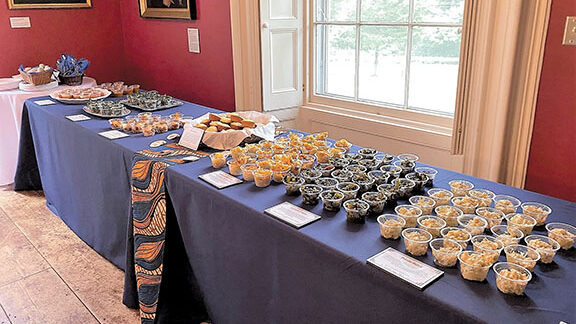Historical Association shares a lesson about slavery through food

By Bob Sacks
MIDDLETOWN – Few people associate the history of Monmouth County with slavery, nor the rest of the state for that matter, yet New Jersey was the last northern state to abolish the act. At the time of the Revolutionary War, much of Monmouth County was farmland, and there was an already well-established population of slave labor living here to tend to the land.
As New Jersey was the southern-most of the northern states, there was even debate as to whether they would align themselves with the North or the South at the outset of the Civil War, before they chose to side with the North. This is not hard to understand since so much of the Garden State was dependent on agriculture for commerce.
The Monmouth County Historical Association (MCHA) found evidence of enslaved men, women and children who lived and worked at Marlpit Hall on Kings Highway in Middletown, among many other historical properties. Highlighting the county and state’s dichotomy when it came to slavery, one wall of the Marlpit Hall dining room even features two side-by-side portraits, one of a prominent New Jersey slaveholder, the other of an abolitionist.
The MCHA chose to create an exhibit at Marlpit, which they named “Beneath the Floorboards: Whispers of the Enslaved,” to display artifacts found hidden in the house and share the story of this little-known chapter of history.
A highlight of the ongoing exhibit was an afternoon of informative presentation Aug. 5, combined with a tasting of African-influenced food – what we now call soul food. Many of the dishes were made by Adanech Asghedom, owner of Ada’s Gojjo in Asbury Park, an Ethiopian and Dominican restaurant. Other dishes were contributed by Jameson’s Southern Cooking in Neptune, and It Takes Two Catering.
Gilda Rogers, professor of English and history at Brookdale Community College, community activist and executive director of T. Thomas Fortune Cultural Center, described the history of the foods in great detail. Following the presentation, guests were treated to a tasting.
“Food sustains us,” Rogers said. “It’s part of every culture, and takes us back to our childhood.”
She explained that African American cuisine “makes the best of any material.”
Rogers listed four of the core ingredients in soul food: okra, rice, black-eyed peas and watermelon. She also explained how macaroni and cheese originated in the United States after Thomas Jefferson’s chef, a slave named James Hemings, adapted dishes that Jefferson encountered in France.
The assortment of foods to taste included sofki, a version of a one-pot meal made from okra, peas, tomatoes and warm spices which is usually served on a flatbread called injera. Two kinds of greens were offered: traditional West African collard greens with kale, prepared with onions and spices; and plain collard greens, representing an easily maintained crop grown by the slaves.
A spicy chicken stew called doro wot is cooked with Ethiopian clarified butter and served with a boiled egg. A classic macaroni and cheese was based on the “macaroni pie” served in Jefferson’s White House. A creamy, tangy potato salad representing comfort food was also offered.
For dessert, peach cobbler, made from an abundant summer fruit, was easy for the slaves to assemble or “cobble” together, after a long workday. A savory sweet potato pie, often served instead of pumpkin pie, was a staple of family gatherings.
Rogers recommended a Netflix documentary, “High on the Hog: How African American Cuisine Transformed America” as an excellent explanation of how many of these foods journeyed from Africa to America.
The exhibit is inclusive of all the people who lived in these historic homes, both slaveholders and the enslaved. It’s eye-opening to tour the property and learn from the volunteer docents about this little-known, vital chapter of New Jersey history.
For those interested in seeing the artifacts and buildings, visits to Marlpit Hall are offered from 1 to 4 p.m. Fridays, Saturdays and Sundays. Details are available at monmouthhistory.org.
Bob Sacks, longtime food and wine buff, writes about food, wine and restaurants. Follow him on Instagram @dinnerwithbob.
The article originally appeared in the August 11 – 17, 2022 print edition of The Two River Times.














